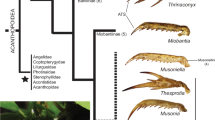Abstract
Numerous zoologists who study diurnal lemurs on Madagascar have noted that they react strongly to the presence of birds of prey. For two of the most intensively studied lemurs, Propithecus verreauxiand Lemur catta,there are few documented cases of raptor predation. Thus, the maintenance of this stereotypic response is enigmatic. Bird bones recovered from cave surface deposits in southwestern Madagascar include the remains of an eagle (Aquila),a genus that has disappeared from Madagascar and that would have been capable of hunting animals the size of adult P. verreauxi and L. catta.The stereotypic response of these two lemurs toward raptors may have been retained from the period when this extinct eagle inhabited the island and is reinforced by rare acts of predation by extant birds of prey.
Similar content being viewed by others
References
Alexander, R. D. (1974). The evolution of social behavior.Amiu. Rev. Ecol. System. 5: 325–383.
Brown, L. H., Urban, E. K., and Newman, K. (1982).The Birds of Africa, Academic Press, London.
Cheney, D. L., and Wrangham, R. W. (1987). Predation. In Smuts, B. B., Cheney, D. L., Seyfarth, R. M., Wrangham, R. W., and Struhsaker, T. T. (eds.),Primate Societies, University of Chicago Press, Chicago, pp. 227–239.
Goodman, S. M., O’Connor, S., and Langrand, O. (1993). A review of predation on lemurs: Implications for the evolution of social behavior in small, nocturnal primates. In Kappeler, P. M., and Ganzhorn, J. (eds.),Lemur Social Systems and Their Ecological Basis, Plenum Press, New York (in press).
Isabell, L. A. (1990). Sudden short-term increase in mortality of vervet monkeys (Cercopithecus aethiops) due to leopard predation in Amboseli National Park, Kenya.Am. J. Primatol. 21: 41–52.
Jolly, A. (1966).Lemur Behavior: A Madagascar Field Study, University of Chicago Press, Chicago.
Jolly, M. (1977). A contribution to the morphology and phylogeny of the Falconiformes.Evolut. Theory 2: 109–300.
Jungers, W. L. (1978). The functional significance of skeletal allometry inMegaladapis in comparison to living prosimians.Am. J. Phys. Anthropol. 49: 303–314.
Lamberton, C. (1939). Contribution à la connaissance de la faune subfossile de Madagascar: Lemuriens et Cryptoproctes.Mem. Acad. Malgache 27: 75–139.
Langrand, O. (1990).Guide to the Birds of Madagascar, Yale University Press, New Haven, Conn.
Macedonia, J. M. (1990). What is communicated in the antipredator calls of lemurs: Evidence from playback experiments with ringtailed and ruffed lemurs.Ethology 86: 177–190.
MacPhee, R. D. E. (1986). Environment, extinction, and holocene vertebrate localities in southern Madagascar.Nat. Geograph. Res. 2: 441–455.
Perrier de la Bathie, H. (1934). Au sujet de l’age de la faune aAepyomis et Hippopotames.Mem. Acad. Malgache 17: 162–168.
Petit, G. (1935). Le lac Manampetsa et la reserve naturelle dite du Manampetsa.Ann. Sci. Nat. (Zool.) Ser. 10 18: 423–437.
Richard, A. F. (1978).Behavioral Variation: Case Study of a Malagasy Lemur, Buckneil University Press, Lewisburg, Penn.
Richard, A. F., and Dewar, R. E. (1991). Lemur ecology.Anna. Rev. Ecol. System. 22: 145–175.
Richard, A. F., Rakotomanga, P., and Schwartz, M. (1991). Demography ofPropithecus verreauxi at Beza Mahafaly, Madagascar: Sex ratio, survival, and fertility 1984-1988.Am. J. Phys. AnthropoL 84: 307–322.
Sauther, M. L. (1989). Antipredator behavior in troops of free-rangingLemur catta at Beza Mahafaly Special Reserve, Madagascar.Int. J. Primatol 10: 595–606.
Struhsaker, T. T., and Leakey, M. (1990). Prey selectivity by crowned hawk-eagles on monkeys in the Kibale Forest, Uganda.Behav. Ecol. SociobioL 26: 435–443.
van Schaik, C. P. (1983). Why are diurnal primates living in groups?Behaviour 87: 120–144.
Wrangham, R. W. (1983). Ultimate factors determining social structure. In Hinde, R. A. (ed.),Primate Social Relationships, Blackwell Scientific, Oxford, pp. 255–262.
Author information
Authors and Affiliations
Rights and permissions
About this article
Cite this article
Goodman, S.M. The enigma of antipredator behavior in lemurs: Evidence of a large extinct eagle on Madagascar. Int J Primatol 15, 129–134 (1994). https://doi.org/10.1007/BF02735238
Received:
Revised:
Issue Date:
DOI: https://doi.org/10.1007/BF02735238




